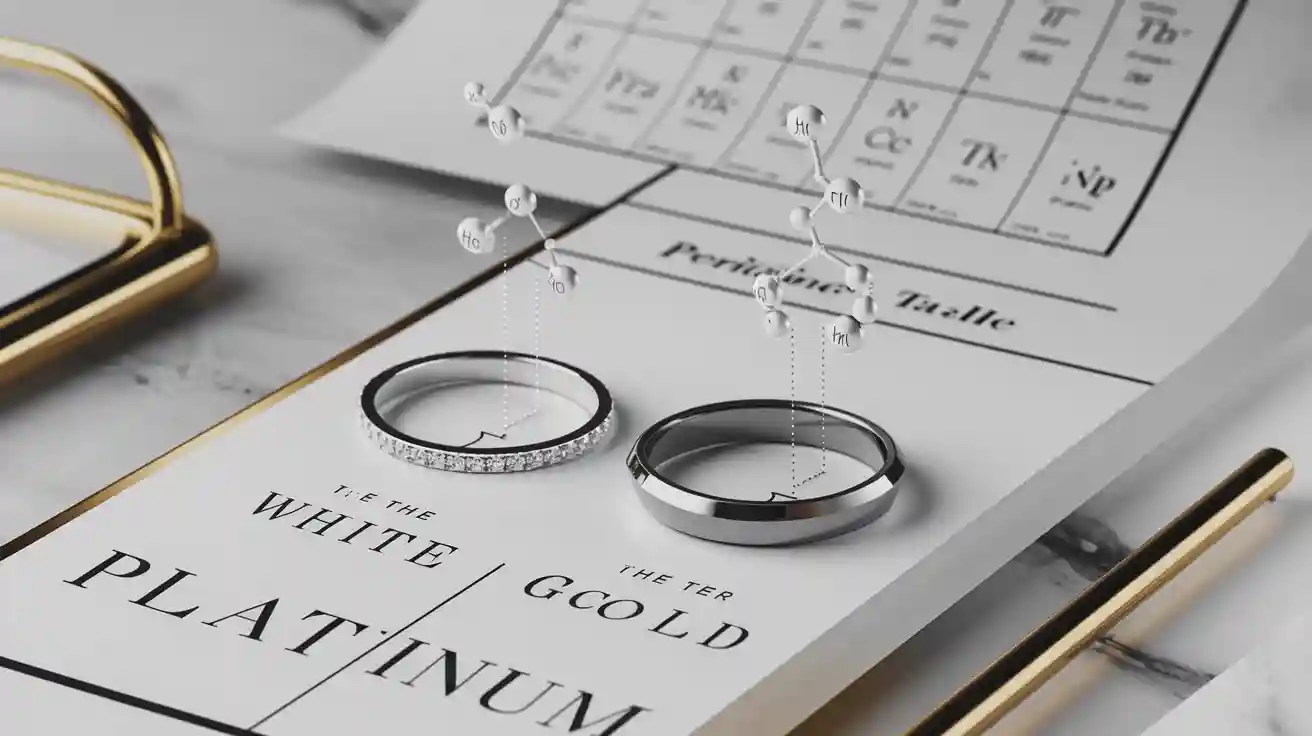
元素分析は、ホワイトゴールドとプラチナの違いを理解するのに役立ちます. 下の表はプラチナがほぼ純粋であることを示しています, まで 99.9%. ホワイトゴールドは、金とパラジウムやニッケルなどの他の金属を混ぜたものです. これらの元素の違いにより、それぞれの金属の見た目が変わります, 感じる, そして続く. ジュエリー購入者はこれらの事実を知ることでより良い選択ができるようになります. 最近の研究 貴金属の元素について学ぶことで、より簡単に、より自信を持ってジュエリーを選ぶことができると言う人.
キーテイクアウト
ホワイトゴールドは金と他の金属を混ぜて作られます. 白く見えるようにロジウムで覆われていることが多い. プラチナはほぼ純粋で、自然な白色です。. プラチナはホワイトゴールドより重い. 強度も高く長持ちします. プラチナはあまりお手入れをしなくても、その色を長期間保つことができます。. これにより、長持ちするジュエリーに最適です. ホワイトゴールドはプラチナよりも硬く、価格も安価です. ただし、光沢と白さを維持するには、ロジウムの再メッキが必要です. プラチナはアレルギーを引き起こさず、敏感肌にも適しています。. ホワイトゴールドにはニッケルが含まれているものもあります, アレルギーを引き起こす可能性があるもの. プラチナは宝石をより適切な位置に保持します. 珍しくて貴重ですよ. ホワイトゴールドは軽くてスタイリッシュに見えます.
元素分析

ホワイトゴールドの組成
元素分析により、ホワイトゴールドが単なる金属ではないことが判明. ホワイトゴールドは純金に他の金属を混ぜて作られます. これらの金属はパラジウムである可能性があります, 銀, ニッケル, 銅, または亜鉛. 混合により金属が白く見え、ジュエリーとしての強度が増します。. ほとんどのホワイトゴールドジュエリーは18Kまたは14Kゴールドを使用しています. 18Kホワイトゴールドは 75% ゴールドと 25% 他の金属. 14Kホワイトゴールドは約 58.3% 金、残りは合金金属. カラット システムは、ジュエリーにどれだけの金が含まれているかを示します.
ヒント: ニッケルベースのホワイトゴールドはより白く見えますが、皮膚アレルギーを引き起こす可能性があります. パラジウムベースのホワイトゴールドは柔らかく、少しグレーに見えます.
以下の表で通常のホワイトゴールド合金の混合を確認できます。:
カラット | 金 (%) | パラジウム (%) | 銀 (%) | 銅 (%) | 亜鉛 (%) | ニッケル (%) |
|---|---|---|---|---|---|---|
18 kt | 75 | 20 | 5 | n/a | n/a | n/a |
18 kt | 75 | 15 | 10 | n/a | n/a | n/a |
18 kt | 75 | 10 | 15 | n/a | n/a | n/a |
18 kt | 75 | 10 | 10.5 | 3.5 | 0.1 | 0.9 |
18 kt | 75 | 6.4 | 9.9 | 5.1 | 3.5 | 1.1 |
18 kt | 75 | 15 | n/a | 3.0 | n/a | 7.0 |
14 kt | 58.3 | 20 | 6 | 3 | 1 | n/a |
14 kt | 58.5 | 5 | 32.5 | 20.5 | 1.4 | n/a |
10 kt | 37.5 | n/a | 52 | 4.9 | 4.2 | 1.4 |
ホワイトゴールドのレシピを変えると、色や硬度が変わります。. 宝石商の中には、より明るい外観にするためにシルバーを追加する人もいます。. 強度を高めるためにより多くのパラジウムを使用する製品もあります. ほとんどのホワイトゴールドジュエリーの上部には薄いロジウム層が付いています。. この層により、さらに白く輝きが増します. 時間とともに, ロジウムは磨耗する可能性があります. それから, ゴールドの黄色が見える場合があります.
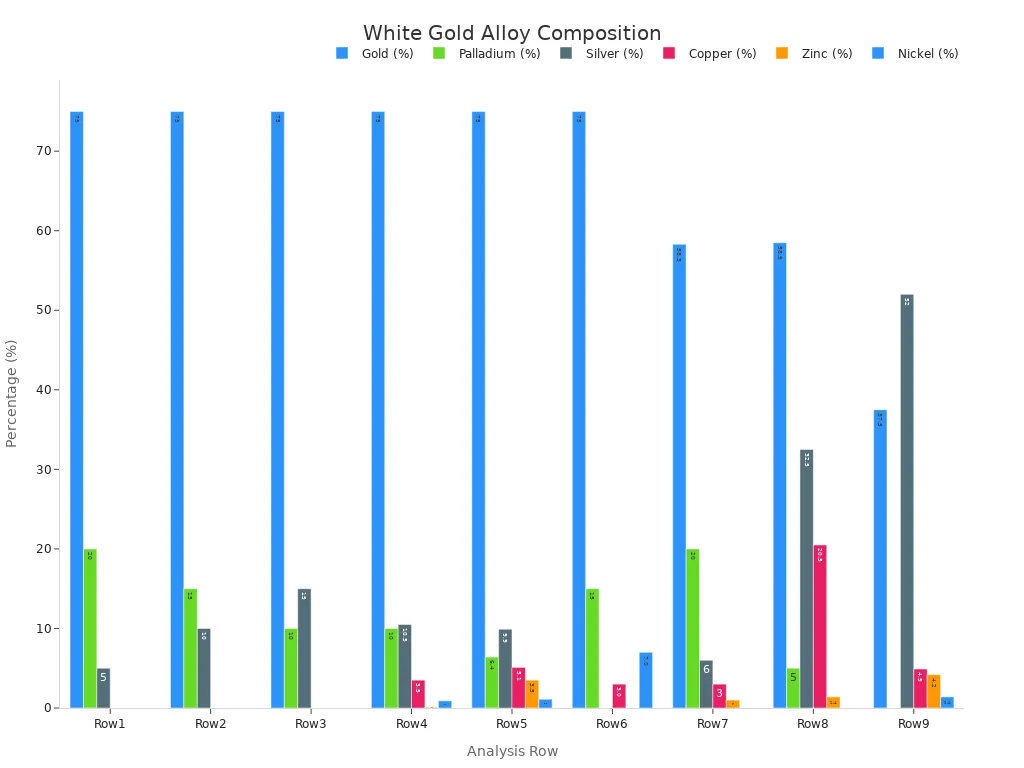
科学研究による元素分析により、ホワイトゴールドには貴金属が混合されていることが示されています. 常にゴールドが主役, しかし、銀とパラジウムも高価になる可能性があります. 例えば, ある研究が見つかりました 銀と同じくらい高い 100,980 10億分の1 (ppb). パラジウムと金の量もレシピによって変わります.
プラチナ組成
プラチナは非常に純粋なので特別です. ほとんどのプラチナジュエリーは、 90% 宛先 95% 白金. 残りは通常、イリジウムなどの他の白金族金属です。, ルテニウム, またはパラジウム. 時々, 宝石商は少量のコバルトまたは銅を添加します. を検索することで純度を確認できます。 PT950やPT900などのスタンプ あなたのジュエリーに.
注記: 米国では, プラチナジュエリーは必須です 少なくとも 95% 白金 品質ルールを満たすために.
これは、一般的なプラチナ合金の混合物を示した表です。:
合金の種類 | 白金 (%) | 合金金属(s) (%) | メモ |
|---|---|---|---|
PT950 | 95 | 5 (そして, ル, co) | 宝飾品に最も一般的 |
PT900 | 90 | 10 (そして, ル) | 高級ジュエリーにも使用されています |
PT999 | 99.9 | トレース | レア, とても柔らかい, 最も純粋な形 |
プラチナ合金は、ホワイトゴールド合金よりも使用する合金金属の量が少なくなります。. この高い純度がプラチナに自然な白色を与えます。. プラチナジュエリーは白く見せるためにロジウムメッキを必要としません. 金属はそれ自体で明るく光沢を保ちます. プラチナの自然な白さはホワイトゴールドとの大きな違いです, メッキが必要なもの.
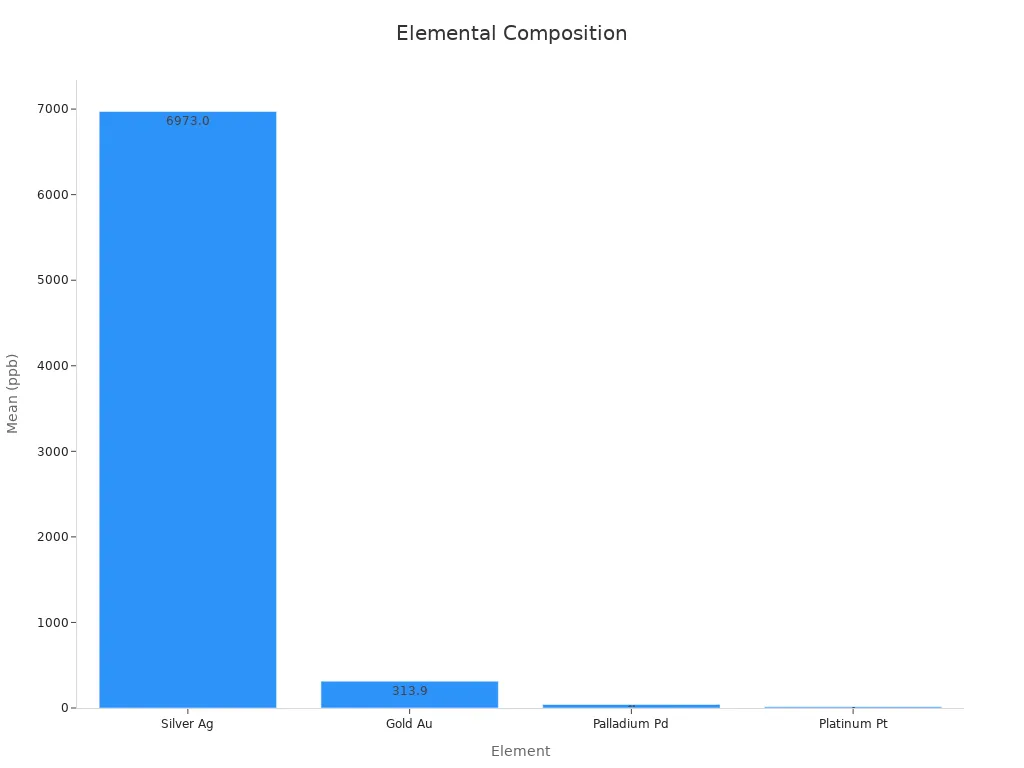
元素分析により、サンプル中でプラチナと金が一緒に含まれる場合があることも判明, しかし、プラチナジュエリーではプラチナの方がはるかに高価です. プラチナの純度は世界中で厳格な規則に従って検査されています. プラチナ ジュエリーには常にこの貴金属が多く含まれていると信頼できます。.
ナチュラル vs. 人工的な白さ
ホワイトゴールドは金属とロジウムメッキを混ぜることでその色が生まれます。. 白い色は自然ではないため、メッキが剥がれると色が薄くなる可能性があります. プラチナは自然な白色です. 色褪せや黄ばみの心配もありません. これは、何年もその色を保つジュエリーが必要な場合に重要です.
まとめ: 元素分析により、ホワイトゴールドとプラチナは素材も見た目も異なることが証明されています. ホワイトゴールドは金属と表面メッキの混合物を使用しています. プラチナは純度が高く自然な白さがある. これらの事実は、ジュエリーに適した金属を選ぶのに役立ちます.
蛍光X線分析計 分析: 構成への窓
XRF分析 非破壊技術を使用して、金属に存在する元素を特定し、定量化します。. XRFを使用してホワイトゴールドとプラチナを比較した場合, 違いが明らかになる:
ホワイトゴールドの金含有量: ホワイトゴールドの金含有量は通常、 58% そして 75%, カラットにもよりますが. 残りの要素, ニッケルやパラジウムのような, are added to enhance the metal’s strength and to achieve the desired color. XRF analysis can clearly reveal the exact percentage of gold and the presence of other alloying metals.
Platinum’s High Purity: 白金, 一方, will typically show a much higher percentage of platinum content, with minimal impurities or alloying metals. This purity is reflected in its weight and density, making platinum jewelry more substantial than white gold of the same size.
Key Differences Revealed by XRF
Purity Levels: XRF analysis will show that platinum is typically much purer than white gold, which often contains a mix of metals.
Elemental Composition: While white gold contains various metals like palladium, ニッケル, and silver, platinum’s composition is predominantly platinum, with small amounts of other metals for enhancement.
密度と耐久性: プラチナの密度が高いことは、XRF でテストすると明らかです。. これにより、プラチナはホワイトゴールドよりも耐久性があり、磨耗に強いという評判が生まれています。.
色: XRF はホワイトゴールド中のロジウムの量の検出にも役立ちます, それはその明るさに貢献します, ホワイト仕上げ. プラチナは本来白いので, メッキは必要ありません.
物理的特性
色と外観
プラチナとホワイトゴールドを比べてみると, 見た目が違うのが分かりますね. プラチナは自然な白色で、柔らかなグレー色をしています。. この色はそのままで色褪せない. プラチナの輝きを保つためにコーティングを追加する必要はありません. ホワイトゴールドはイエローゴールドとして始まります. 宝石商はそれを他の金属と混ぜて白く見せます. 彼らは薄いものを置きます 余分な輝きのための上部のロジウム層. This rhodium makes white gold very shiny, but it can wear off in a year or two. When the rhodium is gone, you might see a yellow color under the surface.
If you want jewelry that stays white for a long time, platinum is a good choice. White gold needs more care to keep looking bright.
Here is a table that shows how the color and shine of both metals compare:
側面 | 白金 (Natural White) | Rhodium-Plated White Gold |
|---|---|---|
Color Appearance | Naturally white with a soft gray color, does not fade | Bright, shiny white because of rhodium layer |
Reflectance | Medium natural shine | Very shiny, reflects a lot of light |
Maintenance | Needs little care, no extra layer needed | Needs new rhodium layer sometimes as it wears off |
Longevity of Appearance | Keeps its color for many years |
Durability and Hardness
これらの金属がどれだけ強いかを知ることが重要です. プラチナは硬いことで有名です. プラチナに傷が入ってしまったら, 金属は動くだけで消えない. これにより、プラチナ ジュエリーの形状と重量が長期間維持されます。. ホワイトゴールドは合金金属が多いため、プラチナよりも硬いです. この硬度により、ホワイトゴールドは傷つきにくくなります。. しかし、ホワイトゴールドに傷がついてしまうと、, 毎回少量の金属が失われます.
ラボテストでは、プラチナ合金が金合金よりも強いことが示されています. プラチナは破損する前にさらに大きな力がかかる可能性があります. ホワイトゴールド, 特に18K, より難しい, そのため、光沢のある外観がより長く保たれます. プラチナは摩耗に強く、錆びたり変色したりしません。. プラチナジュエリーは何年経っても同じ色を保ちます. ホワイトゴールドは、ロジウム層が摩耗すると輝きが失われることがあります。.
テストの種類 | プラチナ合金 | ホワイトゴールド合金 |
|---|---|---|
摩耗試験 | 摩耗試験中に金属の損失なし | 摩耗試験中に一部の金属が失われる |
腐食試験 | 錆びや変色もほとんどありません | 時間の経過とともに色の変化が起こる |
硬度 (ビッカースHV) | 125 18金用HV | |
抗張力 (PSI) | 40,000 宛先 66,000 | 29,000 18Kゴールドの場合 |

強くて美しいものが必要な場合は、プラチナ ジュエリーが賢い選択です. ホワイトゴールドは硬いですが、輝きを保つためにはより多くの手入れが必要です.
重量と密度
プラチナとホワイトゴールドのリングの重さの違いを実感してください. プラチナはホワイトゴールドよりもはるかに重いです. プラチナというのは、 60% ホワイトゴールドより重い. これにより、プラチナジュエリーは重厚感と高級感を与えます. プラチナの重厚感が好きな人もいる. ホワイトゴールドの軽い感触を好む人もいます.
Platinum’s high density also changes how jewelers work with it. Platinum melts at a much higher heat than gold. Jewelers need special tools and skills to make platinum jewelry. The extra weight and special work make platinum jewelry cost more.
If you want a ring that feels heavy, platinum is the best pick. If you want a lighter ring, white gold is a better choice.
Maintenance and Care
White Gold Upkeep
White gold jewelry needs special care for its surface. Most pieces have a thin rhodium layer on top. This layer makes white gold shiny and bright. It also helps protect the jewelry from scratches. The rhodium can wear off after some time. If you wear your ring every day, the layer may fade faster. Experts say you should check your jewelry every year or two. You might need to 頻繁に着用する場合は、毎年メッキし直してください. 着る回数が減れば, ロジウムは最長5年間持続します. 手を洗う, ローションを使って, または、アクティブに活動するとレイヤーの摩耗が早くなる可能性があります.
ヒント: ホワイトゴールドを頻繁にチェックして再メッキし、光沢を保ちます.
ホワイトゴールドにはニッケルが含まれていることもあります. ニッケルは敏感肌の人を悩ませる可能性があります. ニッケルアレルギーを持つ女性は多い. アレルギーがある場合, 肌が赤くなったり、かゆみが出ることがあります. 一部の宝石商はニッケルの代わりにパラジウムを使用しています. パラジウムはアレルギーのある人にとってより安全です.
プラチナの維持費
プラチナジュエリーはお手入れが簡単です. メッキや色落ちの心配がありません. プラチナはそれ自体が白く変色しません. 何年も輝きを保ちます, 毎日着ていても. お手入れには中性洗剤と水だけが必要です.
Platinum is hypoallergenic. This means it almost never causes skin problems. Its high purity makes it safe for people with sensitive skin. You can wear platinum every day without getting a rash.
Platinum gets a soft finish called patina over time. Many people like this look. If you want your jewelry to shine again, a jeweler can polish it.
特徴 | White Gold | 白金 |
|---|---|---|
Needs Re-plating | はい, every 1-2 years | いいえ |
Tarnish Resistance | 良い (with rhodium) | Excellent |
Hypoallergenic | 時々 (if nickel-free) | はい |
Aging Appearance | May yellow over time | Develops soft patina |
注記: Platinum jewelry stays beautiful for a long time and needs little care.
White Gold and Platinum Comparison
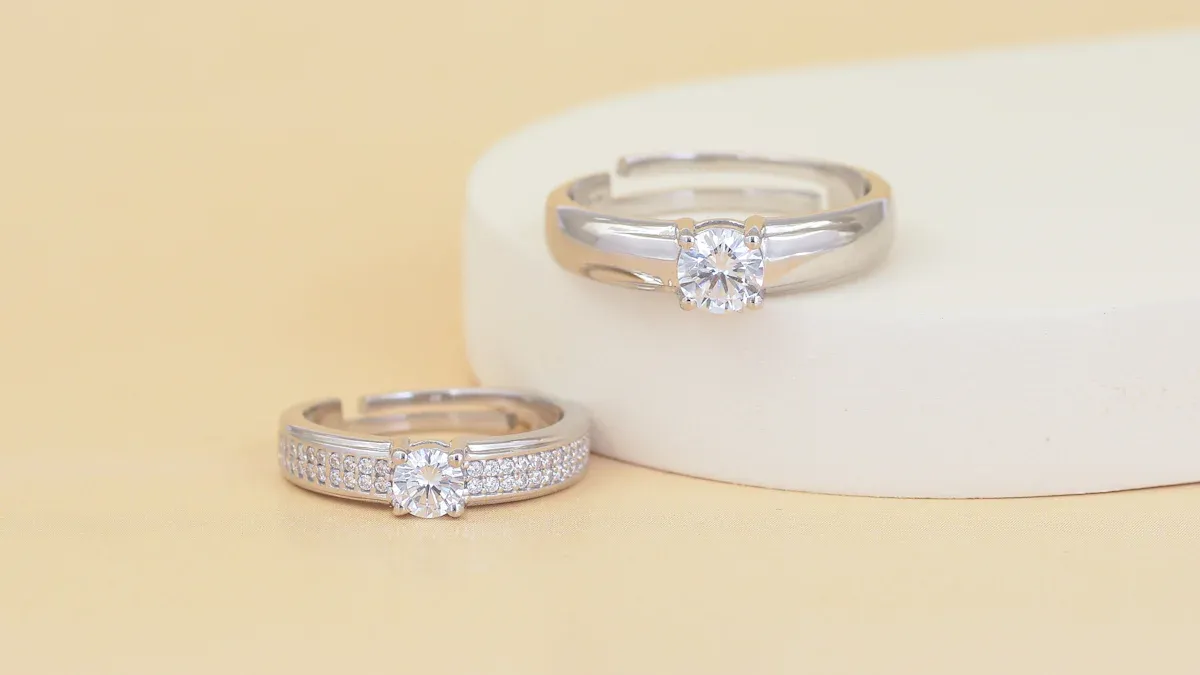
Jewelry Settings
When you choose a ring or pendant, you want your gemstones to stay secure. The metal you pick can make a big difference. a large study by jewelry experts tested how well different metals hold stones. 彼らは、プラチナがホワイトゴールドよりも宝石をしっかりと保持していることを発見しました. プラチナは耐摩耗性に優れています, プロングとセッティングがすぐに摩耗しないようにします。. これは、ダイヤモンドやその他の石が時間の経過とともに落下する可能性が低くなることを意味します。.
ホワイトゴールドは依然として強度があり、多くのジュエリーのデザインに適しています。. 細かいパターンを簡単に成形できるため、宝石商に好まれています。. ホワイトゴールドは多くのモダンなスタイルやクラシックなスタイルで見られます. しかし, プラチナ ジュエリーは、一生使い続ける必要があるセッティングに最適です。. 小粒の石が多いリングや爪が細いデザインをご希望の場合, プラチナはさらなる安心感を与えます.
ヒント: 家宝の作品や毎日身に着けているリングに, プラチナは宝石に最高の安全性を提供します.
快適さと装着性
ホワイトゴールドとプラチナの指への感触の違いに気づくでしょう。. プラチナのリングはホワイトゴールドよりも密度が高いため、重く感じます。. この固さが好きな人もいる, 重量感. ホワイトゴールドの軽いタッチを好む人もいます, 特に一度に複数の指輪を着けている場合.
快適さは金属だけでは決まりません. The バンドの幅と厚さ それも重要. 幅の広いリングや厚いリングは重く感じられるため、快適に使用するにはより大きなサイズが必要になる場合があります. と呼ばれるデザイン “快適なフィット感” バンドの内側に金属を追加します, リングを肌に対してより滑らかにします。. ホワイトゴールドとプラチナの両方をコンフォートフィットスタイルで作成できます.
リングのサイズと形状は毎日の気分に影響を与えます. 浅いバンドは軽くてかさばらないように感じます, しかし、それらはそれほど長くは続かないかもしれません. バンドが広いときつく感じることがある, サイズを上げる必要があるかもしれません. 使用できます 重量を比較するオンラインツール ホワイトゴールドとプラチナのリングを購入する前に.
注記: 両方の金属を試して、どちらが自分にとって最適であるかを確認してください. 日常生活と手にどれくらいの重さを乗せたいかを考えてください。.
ホワイトゴールドとプラチナは同じではないことがわかりました. それらはさまざまな要素でできています. 見た目も異なり、必要なケアも異なります. プラチナはホワイトゴールドより重い. 長持ちし、何年もその色を保ちます. ホワイトゴールドはコストが安い. 多くのジュエリースタイルに適しています. 下の表は、プラチナの時計の価格がゴールドの時計よりもはるかに高くなる可能性があることを示しています. 時々, プラチナ時計の価格は最高です 82% もっと. 金のオンスあたりの価格が高いにもかかわらず、このようなことが起こります。. プラチナは希少で、ジュエリーになるまでに時間がかかります。. そうすることでさらに価値が高まります
レアで強力なものが必要な場合はプラチナを選択してください. より安価で、見た目も美しい軽いリングが必要な場合は、ホワイトゴールドを選択してください。.
よくある質問
敏感肌にはホワイトゴールドとプラチナのどちらが適していますか?
敏感肌の方はプラチナを選んでください. プラチナは低アレルギー性であり、反応を引き起こすことはほとんどありません. ホワイトゴールドにはニッケルが含まれているものもあります, 肌を刺激する可能性があるもの. ホワイトゴールドのジュエリーがニッケルフリーかどうかを必ず確認してください.
ホワイトゴールドはどのくらいの頻度で再メッキする必要がありますか?
ホワイトゴールドは毎回メッキし直す必要があります 1 宛先 2 毎日着ていれば何年も. ロジウム層は時間の経過とともに磨耗します. 定期的な再メッキにより、ジュエリーは明るく白く見えます。.
プラチナはホワイトゴールドより傷つきやすい?
プラチナの傷がつきやすくなる, しかし金属は動くだけで磨耗しません. ホワイトゴールドは硬い, 傷に強くなります. しかし, ホワイトゴールドは傷が付くたびに小さな金属片が失われることがあります.
ヒント: プラチナに傷がついた場合は、磨いて輝きを取り戻すことができます.
ダイヤモンドをよりしっかりと保持する金属はどれですか?
プラチナはダイヤモンドをより安全に保持します. 金属は丈夫ですぐに磨耗しません. 石をより良く保護します, 特に毎日身に着けている指輪では.




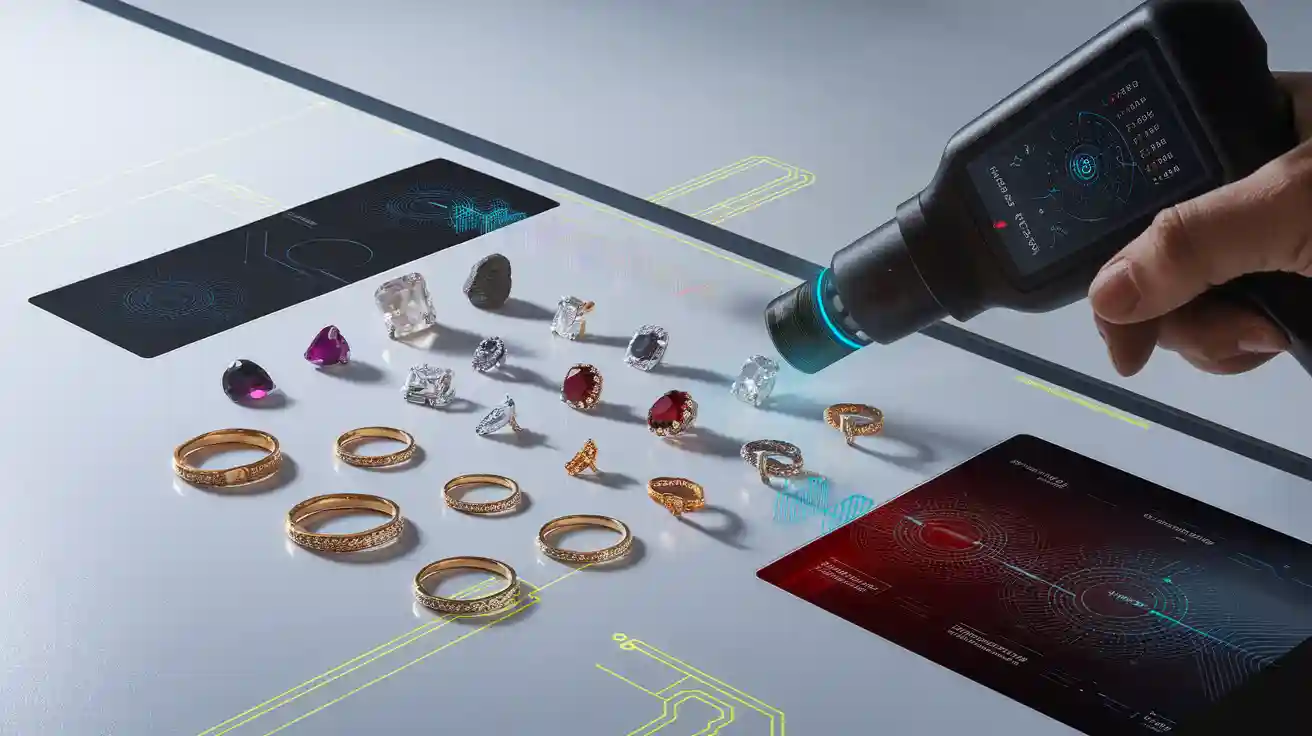

ワッツアップ
QRコードをスキャンして、WhatsAppチャットを開始してください.